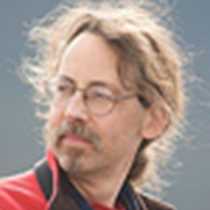Fishing Boat Anchor in Petersburg
We awoke this morning in aptly named Scenery Cove. Not far away the huge Baird Glacier sprawled in its valley, a reminder of what had created the boldly sculpted topography at which we marveled. Nearby we dropped anchor and headed ashore. We walked the trail along Cascade Creek. Just “Cascade” might be more apropos, for the stream never tarries. Rather, it forever roars as it tosses and tumbles in its stony bed. The trail follows a stair-stepping boardwalk through huckleberries, ferns and mosses in such shades of green that even Ireland has never known. This verdancy was regularly rent by the dark and scaly trunks of hemlock and spruce. We had hardly started on the trail when an ever mightier roar filled the air, and we came upon a huge waterfall. Those who professed to be tired of sunshine and to wish for “real Alaskan weather” could get all the mist they wanted here. For some, the waterfall was destination enough, others hurried up the trail, scrambling over boulders and fallen logs, following the allure of what lies behind the next bend in the trail.
By afternoon, we were motoring south through Fredrick Sound, the sun glinting merrily in our wake. The town of Petersburg is all about fishing, and we docked in the middle of its fleet. Here we found trollers, trawlers, trappers and long-liners. Gear aboard the boats called to mind arachnids and anacondas. The palettes and patterns of boats in every state of repair were enough to entertain the hungriest eye or camera. Many of us went for a walk through town. Others used bikes. Some lucky people had chosen the sunny day for flightseeing over Petersburg’s nearby glaciers. Across Wrangell Narrows from town is a trail that leads through forest to a muskeg or bog. This unusual environment is dominated by sphagnum moss, which helps to slow plant decay to the point that few nutrients are available for new growth, and plants grow in stunted “bonsai” forms. We walked through this strange landscape, finding such oddities as carnivorous plants. Indeed, some of us found Alaska’s state insect, the Four-spotted dragonfly, on the way to a sticky end in the embrace of sundew fronds.
As we left Petersburg, we took aboard Andy Zabo, who works with the Alaska Whale Foundation. After dinner, he spoke about the Foundation, and his work studying the foraging patterns of humpback whales.
We had a beautiful day sampling the cultural and natural history of the region, another taste of the richness and variety of Alaska’s Southeast.
We awoke this morning in aptly named Scenery Cove. Not far away the huge Baird Glacier sprawled in its valley, a reminder of what had created the boldly sculpted topography at which we marveled. Nearby we dropped anchor and headed ashore. We walked the trail along Cascade Creek. Just “Cascade” might be more apropos, for the stream never tarries. Rather, it forever roars as it tosses and tumbles in its stony bed. The trail follows a stair-stepping boardwalk through huckleberries, ferns and mosses in such shades of green that even Ireland has never known. This verdancy was regularly rent by the dark and scaly trunks of hemlock and spruce. We had hardly started on the trail when an ever mightier roar filled the air, and we came upon a huge waterfall. Those who professed to be tired of sunshine and to wish for “real Alaskan weather” could get all the mist they wanted here. For some, the waterfall was destination enough, others hurried up the trail, scrambling over boulders and fallen logs, following the allure of what lies behind the next bend in the trail.
By afternoon, we were motoring south through Fredrick Sound, the sun glinting merrily in our wake. The town of Petersburg is all about fishing, and we docked in the middle of its fleet. Here we found trollers, trawlers, trappers and long-liners. Gear aboard the boats called to mind arachnids and anacondas. The palettes and patterns of boats in every state of repair were enough to entertain the hungriest eye or camera. Many of us went for a walk through town. Others used bikes. Some lucky people had chosen the sunny day for flightseeing over Petersburg’s nearby glaciers. Across Wrangell Narrows from town is a trail that leads through forest to a muskeg or bog. This unusual environment is dominated by sphagnum moss, which helps to slow plant decay to the point that few nutrients are available for new growth, and plants grow in stunted “bonsai” forms. We walked through this strange landscape, finding such oddities as carnivorous plants. Indeed, some of us found Alaska’s state insect, the Four-spotted dragonfly, on the way to a sticky end in the embrace of sundew fronds.
As we left Petersburg, we took aboard Andy Zabo, who works with the Alaska Whale Foundation. After dinner, he spoke about the Foundation, and his work studying the foraging patterns of humpback whales.
We had a beautiful day sampling the cultural and natural history of the region, another taste of the richness and variety of Alaska’s Southeast.




